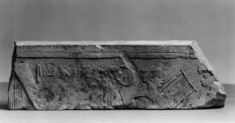Tomb Relief with Funerary Scenes and Inscriptions
(Ancient Egypt and Nubia )
This limestone relief is carved in low relief. The fragment has an upper and lower part and the right edge is broken off. The piece was formerly in two parts (previously as Walters 22.97 and 22.375). The larger fragment was claimed by the vendor to be 18th Dynasty from Luxor.
Provenance
Provenance (from the French provenir, 'to come from/forth') is the chronology of the ownership, custody, or location of a historical object. Learn more about provenance at the Walters.
Larger Fragment: Dikran Kelekian, New York and Paris [date and mode of acquisition unknown] [as 18th Dynasty from Luxor]; Henry Walters, Baltimore, 1930, by purchase; Walters Art Museum, 1931, by bequest.
Smaller Fragment (formerly Walters 22.375): Dikran Kelekian, New York and Paris [date and mode of acquisition unknown]; Henry Walters, Baltimore, 1929, by purchase; Walters Art Museum, 1931, by bequest.
Conservation
| Date | Description | Narrative |
|---|---|---|
| Treatment | other | |
| 1/1/1941 | Treatment | cleaned |
| 1/26/1960 | Treatment | cleaned |
| 7/13/1967 | Treatment | cleaned |
| 6/24/1971 | Treatment | cleaned |
| 4/11/1986 | Loan Consideration | examined for loan |
| 11/27/1996 | Treatment | cleaned; loss compensation; coated |
| 8/31/1998 | Examination | survey |
Geographies
Egypt (Heliopolis) (Place of Origin)
Measurements
H: 7 1/16 x W: 22 5/8 in. (18 x 57.5 cm)
Credit Line
Acquired by Henry Walters, 1930 (larger fragment), 1929 (smaller fragment)
Location in Museum
Not on view
Accession Number
In libraries, galleries, museums, and archives, an accession number is a unique identifier assigned to each object in the collection.
In libraries, galleries, museums, and archives, an accession number is a unique identifier assigned to each object in the collection.
22.97



